
Pozole Rojo
I recently enrolled in a 16-week diploma course in Mexican cooking from the Culinary Art School in Tijuana. Luckily, the course is on-line so I don’t have to travel across the border to attend the classes (which are located only seven miles from my home in Chula Vista). Since I live in a town heavily-influenced by latino culture, I’ve always loved Mexican food such as tacos and enchiladas, etc. However, this time, I wanted to delve deeper into Mexican food, hoping to discover new recipes and their origins.
One of the recipes we had to make was Pozole Rojo, consisting of slow-cooked pieces of pork (including pig’s feet), a rich red salsa, and dried corn kernels that have been converted into hominy. Many people simply buy a can of ready-made hominy to add to their Pozole, however I was required to make mine from scratch. This involves cooking the dried maize (corn) for several hours in a solution of calcium hydroxide (lime) until the hulls separate from the kernels, resulting in soft, toasty-flavored hominy. This process is called nixtamalization and dates back hundreds of years in Mexico before the Spanish conquistadores arrived in the 16th century.
This process took me at least two hours, making me conclude that using a pressure cooker next time would perhaps be a good idea!
Dried red corn kernels before being cooked in lime
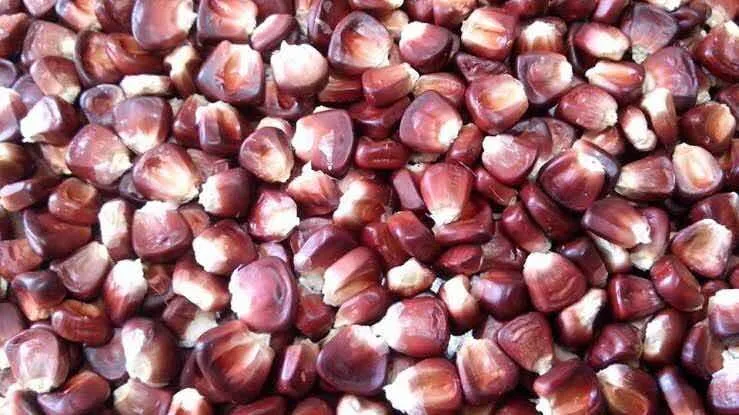
After cooking in lime for around two hours, the hull separates from the kernel, making hominy. Rinse the kernels in running water, then ‘scrub’ the kernels back and forth with your hands to remove any residual skins.
Basic Ingredients for Pazole Rojo
Here are all the ingredients you’ll need for Pozole, including the dried chiles, roasted onion and garlic for the salsa, pork meat (including pig’s feet), garnishes and dried corn with calcium hydroxide (lime) for the hominy. To make things easier, you could just use canned hominy.
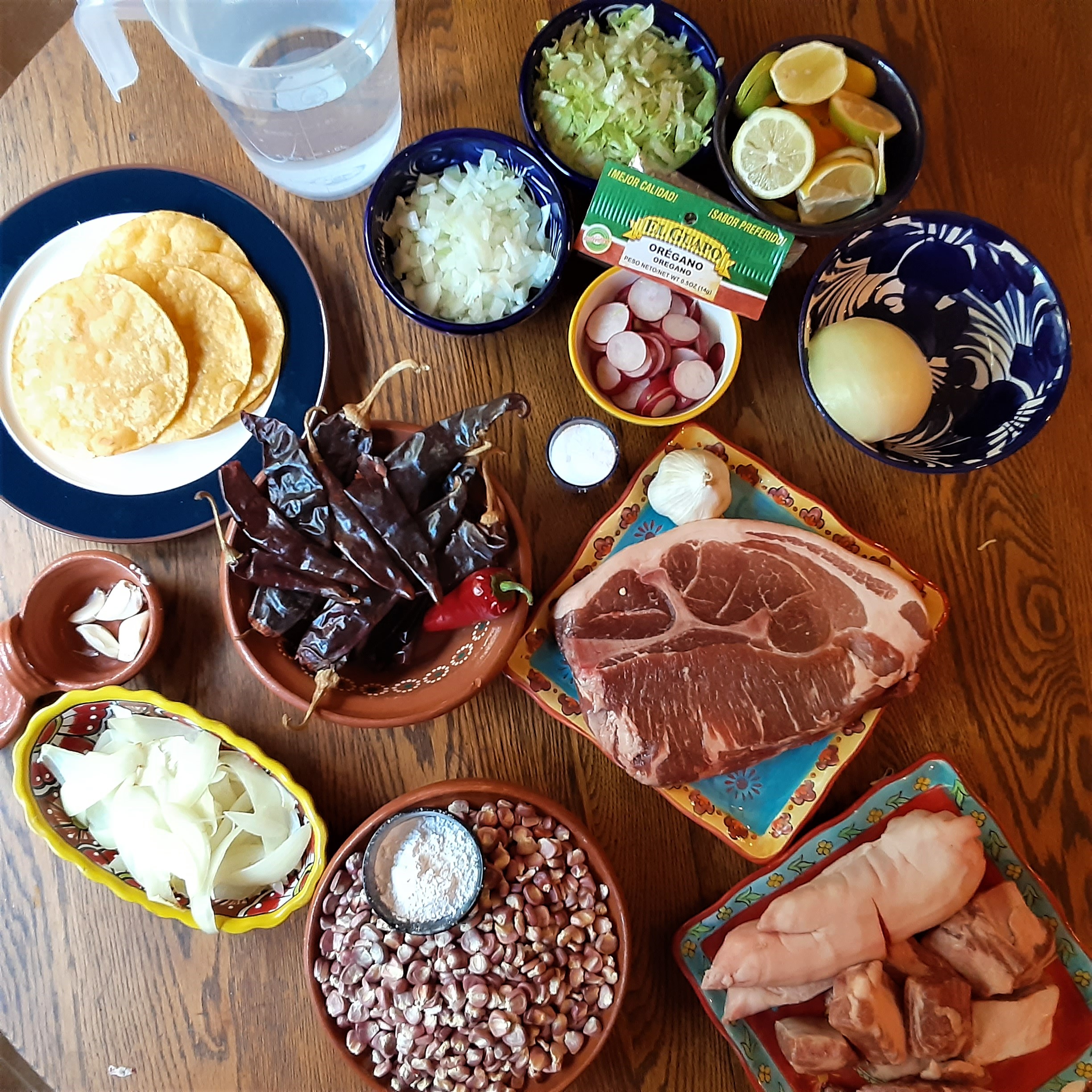
Cooking the Meat (are you game enough to add a pig’s head)?
Place the pork bones, meat, and pig’s feet in a large pot along with an onion and four garlic cloves, cover with water, and simmer for around two hours, or until the meat is tender and falls off the bone. The pig’s feet give off a nice gelatinous flavor, but this is optional. But remember, an authentic Pozole also has a pig’s head cooking in the pot but my butcher didn’t have one on hand!
Making the Salsa
Heat eight dried guajillo peppers and four puya or ancho chiles in a fry pan for several minutes until soft and their color has changed a bit. Remove the seeds and soak in 1/2 cup (or more) of the hot pork cooking liquid. Place the chiles along with the soaking liquid in a food processor, along with the roasted onion and garlic and ‘blitz’ for one minute until smooth. You’ll be adding this later to the meat as it cooks.
Wrapping it all up!
After the meat is cooked and tender, remove the pork bones and pig’s feet from the broth, add the salsa, the prepared hominy, and salt to taste. Continue to cook the mixture for at least another 30 minutes until all flavors are infused.
:max_bytes(150000):strip_icc():format(webp)/__opt__aboutcom__coeus__resources__content_migration__simply_recipes__uploads__2011__10__posole-rojo-method-6-46a8f178d15746a2ab8d40840992191a.jpg)
Add the Garnishes and Enjoy!
There are quite a few garnishes: sliced radishes, lettuce, lemon slices, onions, coriander, and fried tortilla.
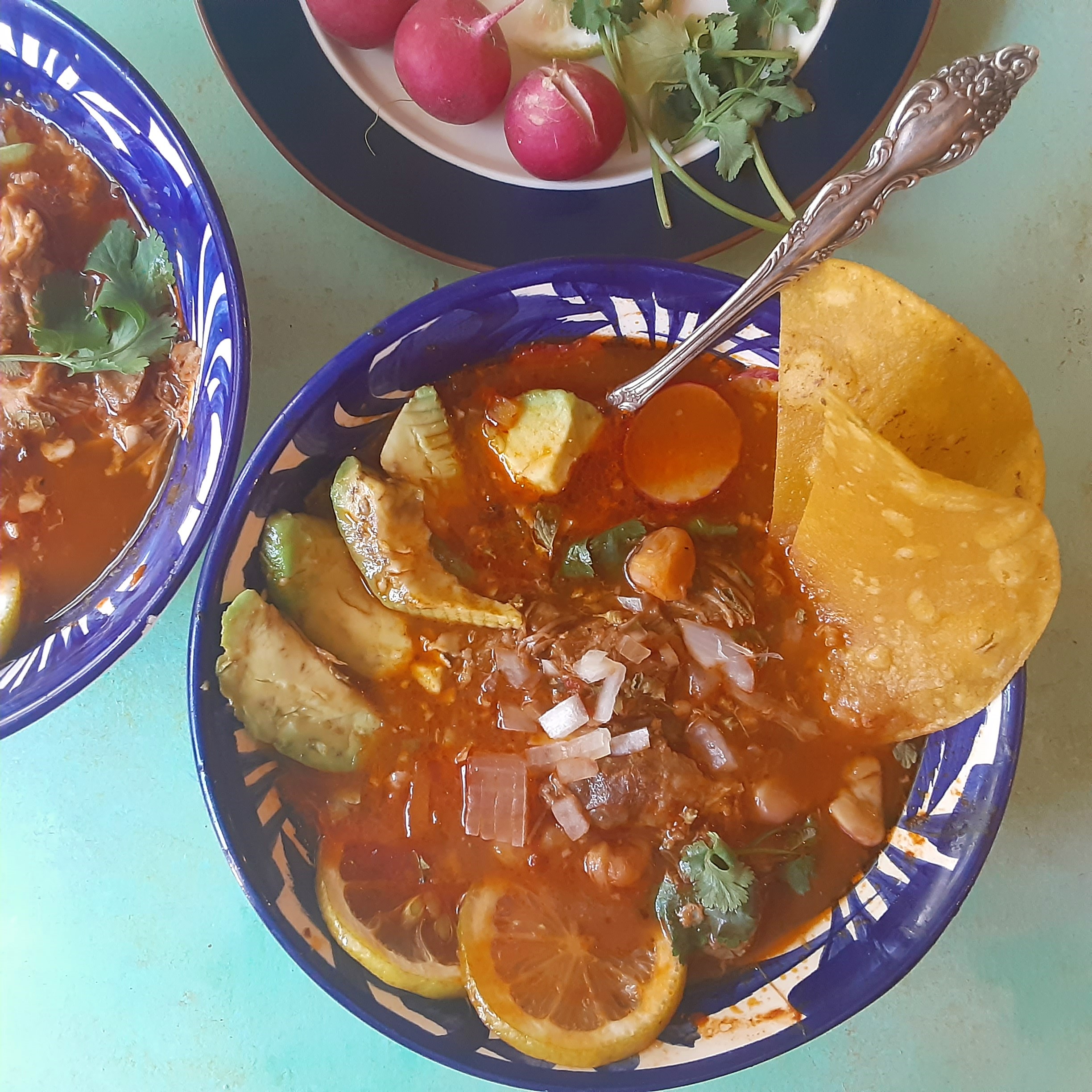
To prepare the hominy from scratch: Place the dried corn in a pot and cover with at least 4 quarts of water. Dissolve the calcium hydroxide (powdered lime) in a little water, then add to the pot of dried corn. Cook over medium heat for several hours or until the hulls separate from the kernels. After awhile, test a few pieces of corn- the skin should easily detach from the kernel. The corn will expand during the cooking, soaking up more water. Add more water, if required. Rinse under cold water then scrub the corn between your hands to remove any residual skin. Alternatively, you could use 3 cups of canned hominy (or more, if desired). To cook the pork: Place the pork bones, pig feet (optional), and pork shoulder or steak in a large pot, cover with water, add the two onion halves, garlic cloves and salt. Bring heat to a slow boil, then reduce heat to medium low and simmer for two hours or until the meat is very tender and falls off the bone. Remove the bones and pig feet from the broth. To make the salsa: Remove the stems from the dried chiles. Place each chile inside a fry pan and heat for 1-2 minutes each side, pressing the chiles into the pan with a spatula. The chiles should soften and change color a little. Remove from heat, cut open each chile and remove all the seeds and any membranes. Using a knife or scissors, chop each chile into 3-4 pieces, then soak for 5-10 minutes in ½ cup hot cooking liquid from the pork. When soft, add the chiles, soaking liquid, roasted onion and diced garlic to a food processor and whizz for 1 minute until the ingredients are fully blended. The salsa should be firm but not watery. Final Assembly: after the pork has cooked, add some of the red salsa to the broth, according to your taste. Add the prepared hominy and cook for another 30 minutes (or longer) until all flavors are infused. Add additional salt according to taste. Serve in individual bowls and top with the garnishes.Pozole Rojo from Scratch
Print Recipe
Ingredients
Instructions

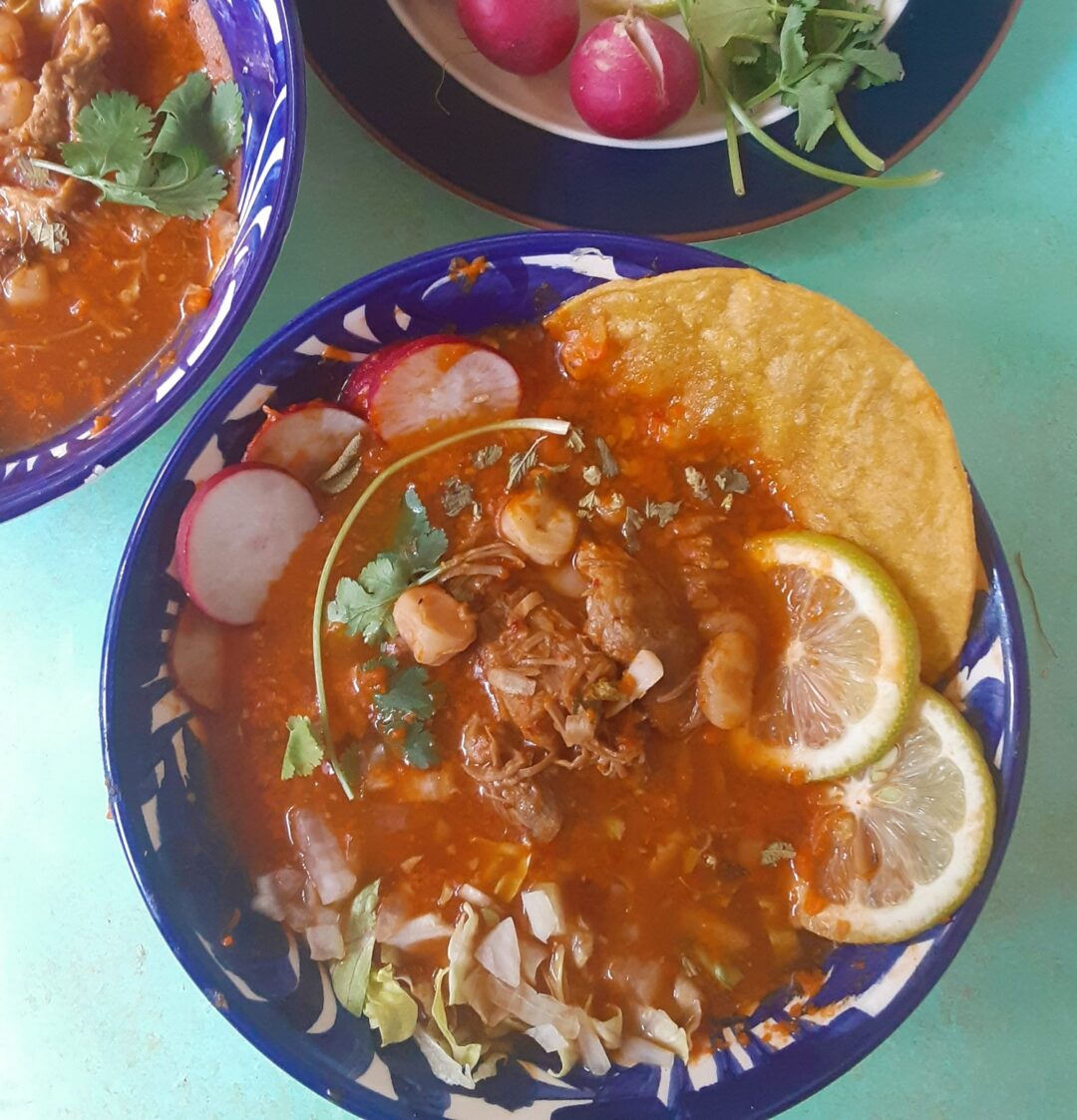
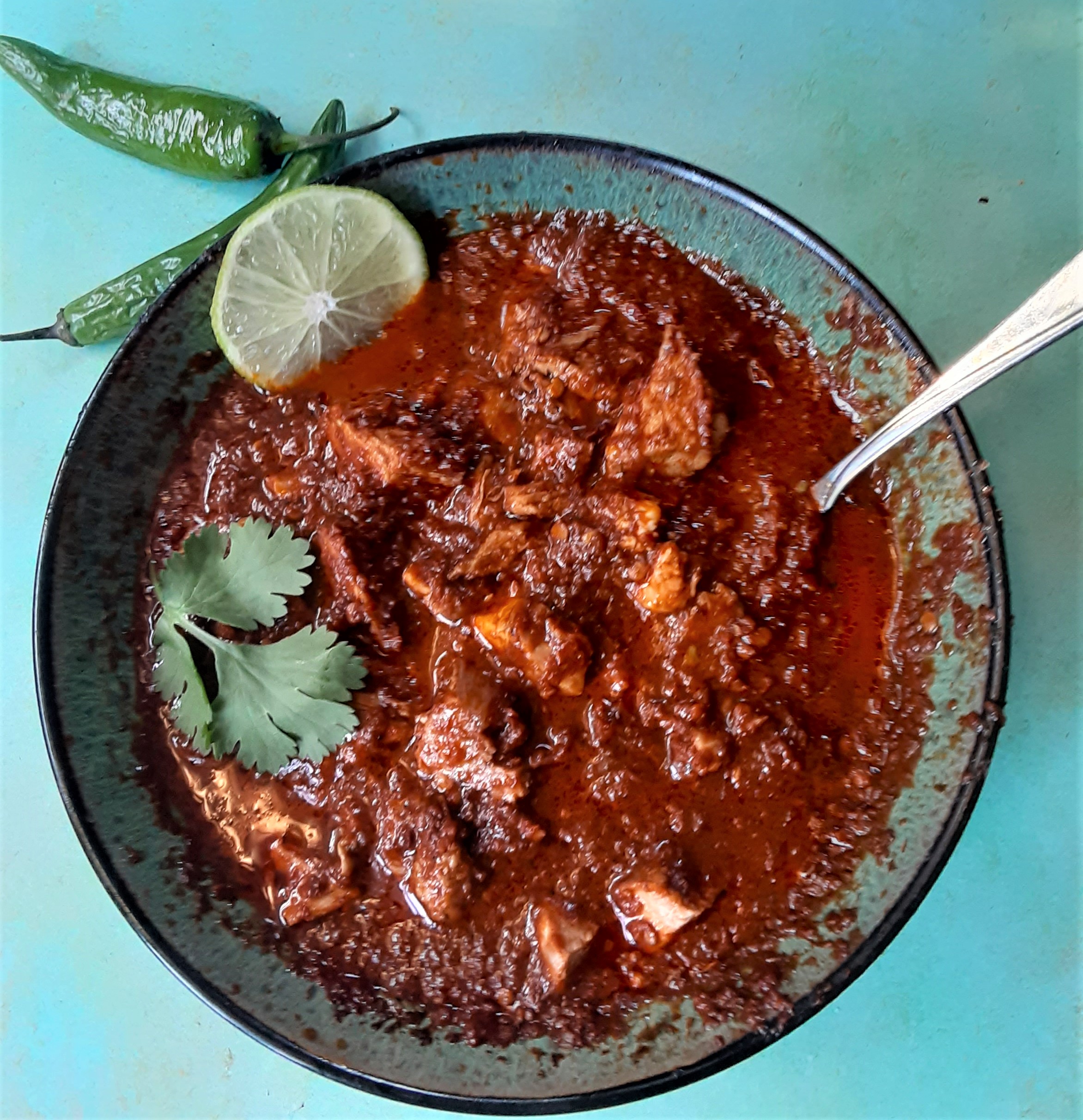
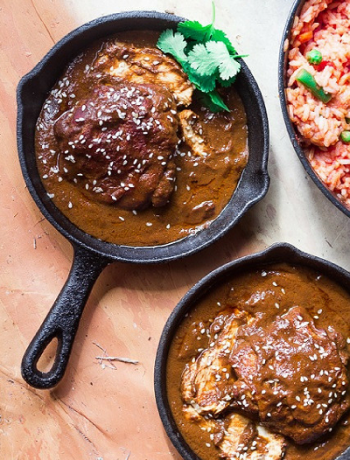
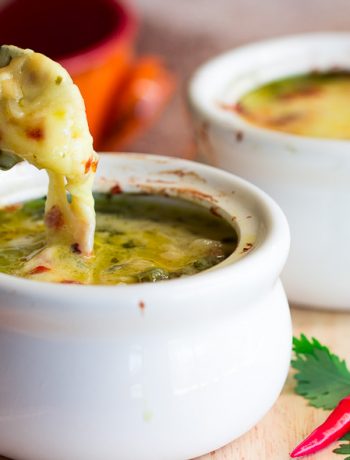
11 Comments
kitchenriffs
February 15, 2022 at 8:02 pmI’m in awe that you made your own hominy! And wow, what a wonderful recipe — this is a feast. Such an entertaining post, and neat dish. Thanks.
Fran Flint
February 15, 2022 at 8:42 pmThanks John for your comment. You always make me feel so much better!
Chef Mimi
February 16, 2022 at 6:00 amThis looks wonderful! I’ve never made my own hominy! And what a great cooking class to experience. I cook Mexican recipes out of cookbooks but sometimes they’re so involved and I can’t get all of the ingredients, so I never really know what they’re supposed to taste like!
Fran Flint
February 16, 2022 at 7:26 amThanks Mimi. Thankfully, I have access to most ingredients that I need for Mexican cooking, except for a pig’s head!
Angie@Angie's Recipes
February 18, 2022 at 3:39 amThis looks like a lot of works! Pig feet are one of my favourites :_-) It’s wonderful that you are even making salsa from scratch and I enjoy how adventurous you are in the kitchen. Bring the pig’s head on next time :))
Fran Flint
February 18, 2022 at 8:11 amAngie, it is a lot of work, but I think next time I will either use a pressure cooker to speed up the making of the hominy (or maybe even use canned hominy)!
David Scott Allen
February 20, 2022 at 12:49 pmThe very first time I made posole, I tried to use dried hominy. It was a disaster! It never ever softened! Ever since, I’ve been happy to use canned hominy and have been quite content with the results. Would love to try your recipe, and it’s the perfect season for it.
Fran Flint
February 22, 2022 at 7:13 amDavid, I know what you mean! It took more than two hours for the dried corn to soften and for the skin to fall off for the hominy. The only way I would do it again would be to use a pressure cooker. However, maybe I’ll try using canned hominy next time!
Jean | Delightful Repast
March 5, 2022 at 6:19 amFran, this is marvelous. Though I’ve never been a fan of hominy, I know I would enjoy the experience of making my own and I’m sure it would be better than what I’ve had (probably canned). I’m a bit too squeamish to utilize pig feet and heads, so I’d leave those out, but this dish looks scrumptious! Let me know how it turns out when you substitute canned hominy.
Fran Flint
March 5, 2022 at 7:31 amHi Jean! It’s been quite awhile since I’ve heard from you. Thanks for your comment and glad to see you are still blogging!
Jeff the Chef
March 7, 2022 at 8:38 pmHow incredibly adventurous! I will probably never cook with a pig head. Maybe not feet, either … although my grandfather used to love pickled pig’s feet, so they’re at least familiar to me. But set the fish in front of me, and I’d try it, any day!